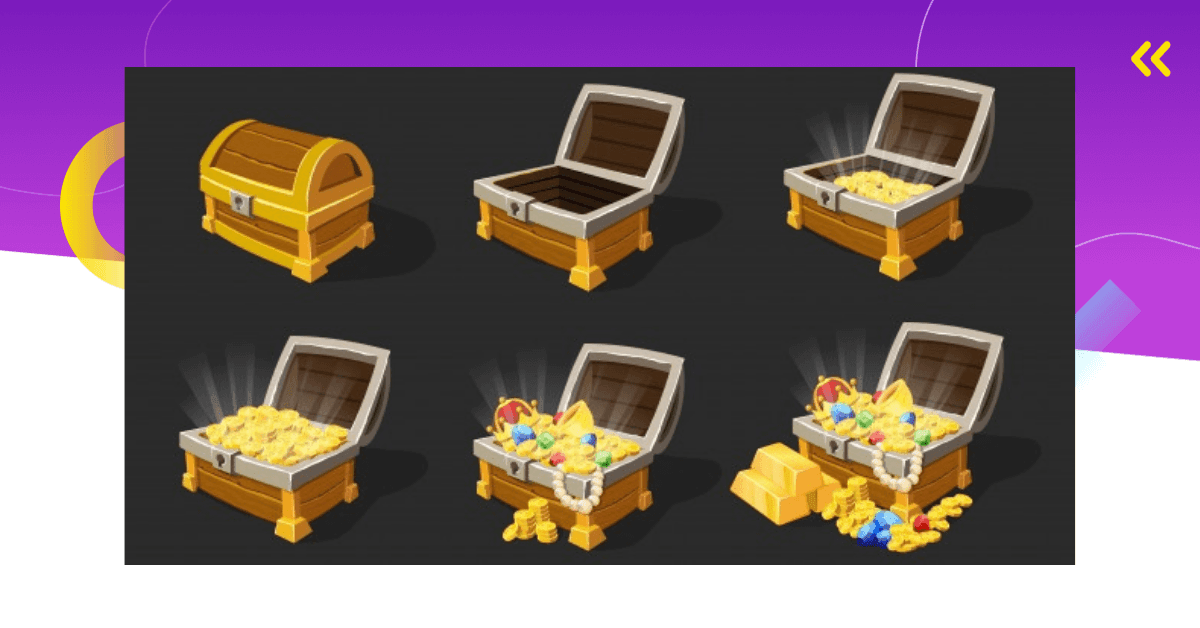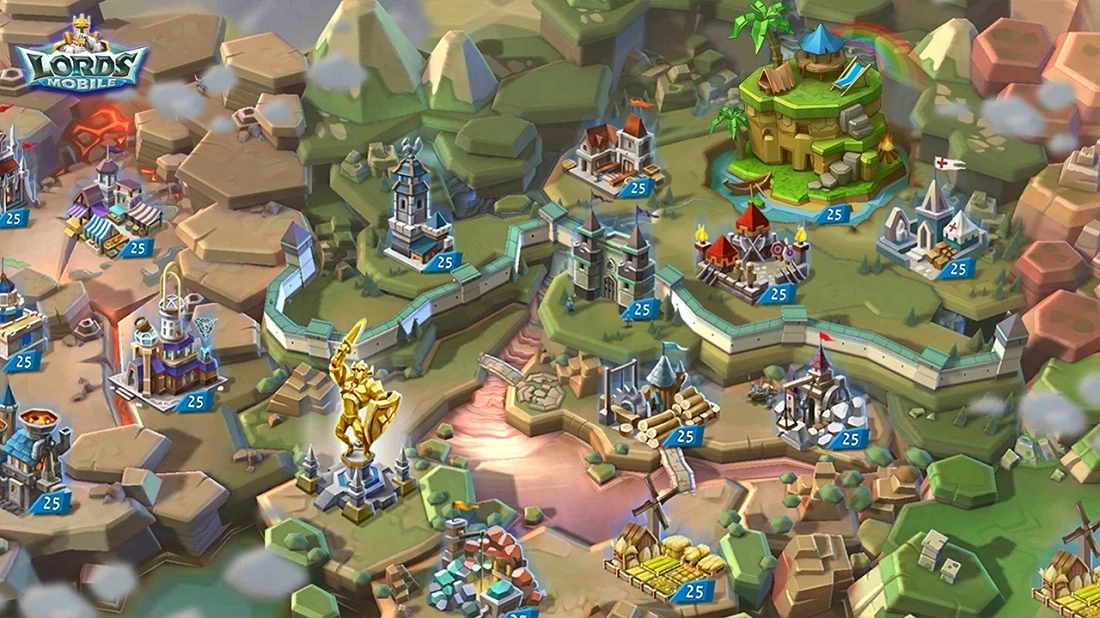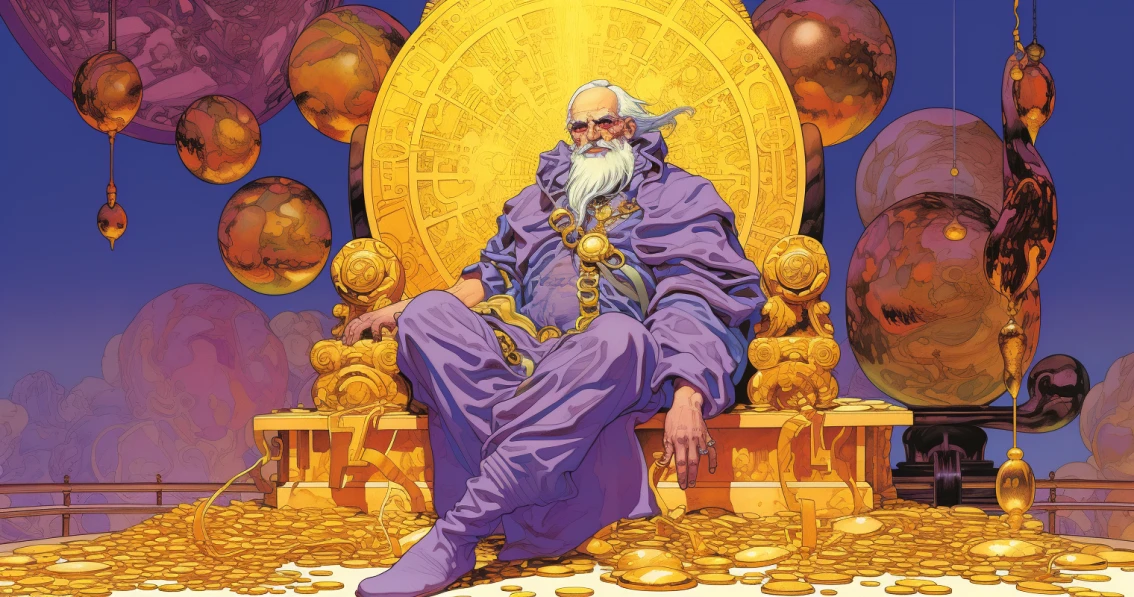Building a game economy can be described as many things, but simple is not one of them. One of these not-so-simple things is creating a balanced mobile game economy.
You don’t need to have a degree in Economics to achieve this. However, if you want to create a successful monetization strategy, you need to have some basic understanding of economics and balance.
Let me help you with that.

About Mobile Game Economy Design
Just like real-world economies, mobile game economies are not easy to manage.
Mobile game economies are also known as virtual economies. These systems refer to the production, distribution, and consumption of virtual goods. This includes currencies, price points, levels/stages, time loops, player progress, etc.
All of this requires a lot of balancing.
This is where game economy design comes into play.
Game economy design is the process of creating a design framework that handles the players’ in-game experience. This is done by predicting the player’s in-game actions.
Victory and loss.
Free-to-play time and pay-to-play time.
Frustration and enjoyment, etc.
The ultimate goal of game economy design is to encourage player behavior that aligns with the game’s main goals. All things considered, it is mainly about numbers and how these numbers help shape the players’ in-game experience.
If you want to design a balanced game economy, you need to take three things into account:
- The game’s progression mechanics
- The game’s main features and how they are configured
- What players can buy in the game and where
Having a balanced mobile game economy is especially important for games that monetize with in-app purchases. These games need to push players towards making in-app purchases. Then again, they shouldn’t make it impossible for non-payers to progress.
Moreover, if a game includes in-app purchases and in-app ads, a balanced mobile game economy becomes a must.
Creating Balanced Mobile Game Economy: Terms You Need to Know
It’s almost impossible to discuss mobile game economies without understanding some basic game design and economic terms.
Let me guide you through a couple of them.

Taps, Sinks & Pinch Points – Wait, What?
You can visualize a game economy as a flow of resources between its features and the players.
This is where two helpful game design terms come into play – taps and sinks.
A tap is where a resource comes from. Just like that tap in your bathroom that brings you warm water. In mobile games, this is, for example, the source of hard currency.
On the other hand, a sink is where the player spends this currency. For example, equipment players can buy with hard currency.
Logically, if the tap is releasing too much currency, the sink will overflow.
If this happens, this will result in excess currency, which will decrease its value. Finally, if the resource, i.e., currency, becomes worthless, the players won’t be motivated to interact with the tap again.
Just like this can happen, the opposite can occur as well.
If the tap is producing too little currency, this is not good either. The thing is, this gives players very little motivation to engage with it in the first place.
The key? Balance.
In mobile game economies, this balance is called a pinch point. This is the point at which the users are concerned about the supply of a resource. As a result, this should maximize the demand for this resource.

Inflation
I’m sure you’ve heard of the term inflation being used in real-life economies.
Inflation happens when the amount of currency in circulation rises to excess amounts. This causes a rise in the cost of goods and services. As a result, the value of the currency decreases.
In the real world, central banks print out money.
In mobile games, it’s the players who “print money”. However, you determine the conditions.
In other words, players produce currencies and resources by engaging with the game’s taps. For example, by completing levels, killing enemies, or trading items.
In order to keep players invested, mobile games should regularly introduce new taps. The more time players spend in a game, the more they crave new and interesting features. Introducing new taps helps developers achieve exactly that.
Hyperinflation
When players “print out” so much currency that it becomes meaningless, this causes hyperinflation.
This is something that frequently happens in games that have been on the market for a while. With mobile games aging and developers not handling balance, players find loopholes.
These loopholes allow them to produce in-game currency, which kills the economic balance.
Intentional Inflation
Inflation is not necessarily a bad thing. In fact, some game developers go ahead and create intentional inflation.
However, intentional inflation has to be well-balanced.
Developers can balance out inflation by adding additional sinks to the game. This should counteract the introduction of additional taps and help maintain a balanced mobile game economy.
Intentional inflation is most common in mobile games with RPG features. For example, games that include upgradable equipment items.
By introducing new and better items, players can progress faster and earn more resources. At the same time, developers can follow up on this by increasing the cost of these items.

Still not quite clear? Here’s an example.
Let’s say a game includes a gold mine. In it, players can buy equipment items that help them mine. For example, a shovel for 200 coins. When players first start playing, this shovel generates one gold per second.
If players progress, they get a chance to buy an upgraded shovel. This one generates double the gold per second in comparison to the first one. Since this shovel is so much more useful than the first one, it should cost more, e.g., 400 coins.
This makes players feel like the game is rewarding them for their hard work, i.e., they get to mine more gold. When in reality, they actually need to sink more currency to get the upgraded item.

Types of Mobile Game Currencies
How complex your game economy will be depends on how many in-game currencies you’ll include. The most common ones are hard and soft currency, games that use just the two have dual economy, but you can add many more different currencies to your game.
This adds depth to the game as well as additional monetization opportunities. However, the more currencies there are, the harder it is to create a balanced mobile game economy.
Which currencies you choose and how many depends on the game genre. For example, complex mid-core and hardcore games usually call for many different types of currencies, while simple hyper-casual games don’t.
However, we see more casual developers utilizing additional currencies to create more complex game economies and thus have more monetization opportunities while also boosting player engagement and retention.
Here are the most common currencies you need to know about.
- Hard currency – The game’s most valuable currency. Most games that monetize with in-app purchases include this type of currency. Its sources need to be limited.
- Soft currency – Should be fairly easy to earn through playing the game. Can be used to purchase game items.
- Medium currency – In between soft and hard currency. Can be obtained through gameplay, but has some limitations.
- Premium currency – The game’s most important currency. Bought with real money.
- Energy currency – Used in games where players’ sessions are limited by the amount of energy currency they have. Players have the option to wait or buy more energy.
- Social currency – Can be acquired via some kind of social activity. It helps increase player engagement and retention.
- Feature currency – Directs players to different game modes. It can also isolate a certain game feature from the game economy.
- Event currency – Special currency players can earn by participating in various events. Adds more depth to the game and increases engagement.
- Guild currency – Related to in-game communities. Unlike other currencies, it’s generated by a group of players.
- VIP currency – Often comes in the form of VIP points players earn by logging in daily, purchasing special VIP items, purchasing bundle items, etc.
- Discard currency – Also known as dust. Players get this currency by destroying in-game items.
- Informal currency – Game assets that players start using as means of payment without the developer intending it that way.
For a detailed explanation and examples of these currencies, check out my article on 12 Types of Mobile Game Currencies.
Tips for Building a Balanced Mobile Game Economy
Once you know the theory, it’s time to put it into practice.
Let’s go over the basic steps for creating a balanced mobile game economy.

Base Everything on Universal Resource
Different games from different genres have very little in common. However, there is one resource crucial to all of them – time.
For example, players spend a certain amount of time playing the game. The more time they spend playing, the better the chances they will spend. Every time they launch the game, you can hit them with the right offers.
I think it’s pretty clear where I’m going with this…
As you can see, time is a universal resource. For this reason, you can compare time to all other game resources and values. For example, to rewards or level competition.
Basically, you want to determine the time it takes a player to achieve a goal value. For instance, to beat a level or earn a reward.
Only when you understand what your players strive to achieve can you react adequately. By reacting, I mean balancing game difficulty and player satisfaction.

Know Your Player Archetypes
One of the foundations of game economies is knowing the game’s basic values.
To define it, basic game values are the things that motivate players to spend more time in it.
In order to really understand game values, you should segment players by what they value most in the game.
According to Game Developer, there are four main types of players by their in-game preferences.
- Explorers, who enjoy discovering new in-game content, e.g., the narrative;
- Achievers, who are focused on progressing and the means they need to progress;
- Socializers, who enjoy the social aspects of the game, e.g., chat;
- Killers, who are all about competing and winning against opposing players.
According to Facebook Gaming, this list is even longer.
They have identified eight player motivations, i.e., the main reasons people play mobile games. This includes self-expression, social connection, progression, expertise, discovery, power, escapism, and relaxation.
Either way, almost all mobile games attract players with different reasons to play.
For this reason, developers need to take all of these types of players into account.
For example, you may find out that 80% of your audience consists of Socializers. Does this mean you should base your economy on them? Not necessarily. It is possible that this major group of players doesn’t spend as much money on the game.
On the other hand, you may know that 15% of your audience consists of Killers. Not such an impressive number, right? Yet, it is perfectly possible that this player archetype would drive your game’s revenues.
For this reason, you need to know your players’ archetypes. Equally important, you need to analyze their spending habits.
Based on all this, you will know which group to focus on. Moreover, you will be able to create a balanced game economy. Even better, a balanced mobile game economy tailored to YOUR audience.

Example of Player Archetypes in Call of Duty: Mobile
This popular shooting game attracts players with different reasons to play.
Here are some of them.
Call of Duty: Mobile attracts the Killers (no explanation required), the Socializers (players who enjoy playing as a team), but also the Achievers (players focused on better equipment and leveling up).
Which one of these groups drives the game’s revenues? We can’t know with certainty. However, the developers know this, and they’ve made a balanced mobile game economy accordingly.
Killers and Achievers are most likely to buy items that help them do better in the game. However, this game doesn’t sell a lot of progression boosters, but only minor perks. If the game offered too many progression items, it would ruin the gameplay balance.
For this reason, it is mainly focused on selling cosmetic items.
Socializers seem most likely to buy cosmetics, so they can show off their fancy skins to their teammates.
However, the Killers and Achievers are also likely to buy cosmetic items, but for other reasons. For example, new skins or weapon skins can make them feel more powerful.
All in all, this game’s offerings are a great fit for its player archetypes, and they are well balanced with gameplay.

Set the Currency System Right
Mobile game currencies are one of the pillars of the freemium game economy. They are also the core of the mobile game economy design.
In most cases, mobile games have two currencies, called hard and soft currency.
Hard currency is the game’s most valuable currency. Players can only earn small amounts of it through gameplay. On the other hand, soft currency can be easily earned by playing the game, and it’s less valuable than hard currency.
It’s incredibly important how you implement these two currencies in your game. Here’s what you need to look out for:
- If the players find it too difficult to generate any of the two currencies, their desire to earn them will be affected. When players spend a lot of time in the game and rewards don’t follow, they won’t like it.
- If earning any of the currencies is too easy, this decreases the value of in-game rewards. In this case, the game becomes boring and unsatisfying.
Your goal here is to make sure both currencies bring certain value to players. For this reason, the form and frequency of currencies are essential.
Let’s say players get 50 gems (hard currency) for completing each level.
If this is the case, you should analyze what this means for your game. For example: How much does it take for a player to finish a level? Is it ten minutes or one hour? How much will it take for the player to get to 300 gems they need to upgrade?
You can analyze the soft currency in the same way.
As you can see, the time points are what matters most here. By defining these time points, you create a schedule. Based on that, you can adjust the pace at which you will be handing out currencies.
By doing all this, you want your players to feel the need to purchase more currency. All in a way that doesn’t feel aggressive and off-putting.

Separate the Game’s Resources
All mobile game resources can be split into two categories – investment and non-investment resources.
Investment resources are all the resources that affect the players’ progress. For example, boosters, keys, equipment, weapons. All of these items affect the gameplay balance.
For this reason, you need to make them limited.
Sure, you can give players an occasional booster to help them finish levels faster. However, you need to put this in your calculations. More precisely, you should express it in terms of time.
For example, you can observe how giving players a booster every three minutes impacts their in-game behavior. Ask yourself questions like: Does it work better than doing it on a five-minute basis? How does it affect long-term profits?
Non-investment resources, on the other hand, don’t directly affect the players’ progress. For example, cosmetic items like skins or clothing.
If your game includes both types, you need to observe how they affect each other.
In this relationship, you need to pay special attention to investment resources. Every time you let them out of the box for free, you must observe how they affect the other type. For example, whether they ruined the players’ desire to buy cosmetic items on level five or not.

Create an Emotional Rollercoaster
While playing a mobile game, players should experience different emotions.
They should feel the sweet taste of victory but also the not-so-sweet taste of defeat. Sometimes, things should be super simple; sometimes, they should be more difficult. In one moment they should feel rich; in another, they should feel poor.
You get my point.
Now, what causes all of these emotions?
In most cases, having more or less of something (e.g., in-game currency). In economic terms, this is called a deficit and a surplus.
For the best possible results, players should experience a surplus in some moments and a deficit in others. According to Game Developer, players should experience two to three emotions per session.
Here’s what I mean by that.
If a level is incredibly difficult and players are facing a deficit, they will probably get frustrated. At that point, some may decide on a purchase to pass the level more quickly.
However, the majority will decide to come back to the game later and try again. If they do that, you shouldn’t allow them to get frustrated several times in a row.
To help them out, you can, for example, give them a daily reward that will help them pass the level. This should make players happy and encourage them to keep playing the game.
Spread the Content between Days
In mobile games, it is very important how you distribute content over time.
Let’s say you want your players to play your match-3 game for at least 15 days. During this time, you expect players to pass 40 levels and buy a booster at least once.
What should their user experience look like from day one to day 15?
The formula is quite simple.
In the beginning, you should be giving out content generously. However, as the days go by, this should thin out.
The players’ first few sessions should be rewarding.
During this time, they need to learn to appreciate the game’s resources. And there is no better way for them to get there than to try them out.
In the beginning, the players should be able to progress quickly. For example, in the first four days, they should be able to pass 20 levels.
Here’s an example of how you can distribute content. In this example, with one of the players’ favorites – boosters.
On day two, you can introduce one type of booster and new ones on days three and four. After that, wait until day six, when you will introduce the final type of free booster.
In the days in between, players will start struggling to finish levels.
During this period, the players will become aware of the game’s four types of boosters. Plus, as the levels get more challenging, their desire to purchase them should become stronger and stronger.

Balancing between In-App Purchases and In-App Ads
Is your game one of many that rely on a mixed monetization model?
This can be a real goldmine.
By utilizing both of these models, you can monetize both payers and non-payers. Hence, you’re not leaving almost any money on the table.
Oh, if only things were this simple…
One of the developers’ biggest fears is that introducing ads will cannibalize in-app purchases.
The fear is justified, but there is no place for it, as long as you stick to best practices.
In a mixed monetization strategy, developers mainly rely on opt-in ad formats. In most cases, on rewarded video ads. Remember, a lot of players actually like this ad format. According to TechCrunch, 68%! This should chase at least some of your fears away.
When it comes to the results of this strategy, it all comes down to a proper balance between IAPs and ads.
Here are some of the things you need to pay attention to.
Introducing Ads to the Mix
Most games that monetize with this model use in-app purchases as the primary monetization strategy.
For this reason, they usually don’t start showing ads right away.
The right time to start showing ads is when the chances of converting users become low.
I can’t tell you exactly when this will happen, but your metrics can.
You need to introduce ads early enough for players to be aware of them. However, this shouldn’t happen before players are fully onboarded.
When players start needing assistance, they should be introduced to IAP options first. Only when this proves inefficient, it’s time to display ads.
It all comes down to situational context. In the right situation, players will respond to in-app ads better.

Example of Introducing Ads in EverMerge
EverMerge doesn’t make players aware of ads from the start.
Instead, it waits until players start needing assistance. Up until level five, players can enjoy gameplay to the fullest. But, at that point, they begin lacking resources.
For this reason, the game first brings players a special offer – a Starter Bundle. This is intended to become the players’ first purchase.
Since most players will skip the offer, the game soon switches to plan B.
On level six, EverMerge introduces its first ad placement. In it, players can buy some extra energy by watching an ad.
In the sessions that follow, the game introduces its remaining ad placements. This way, it gets to earn money from its engaged but non-paying player base.

Using Ad Rewards as Samples
Whenever I see a person promoting something, I get the instinct to run off. However, it cheers me up when the same person tells me I can get a sample with no strings attached.
Why not take the free chocolate? In fact, I’ll take five just in case.
People like receiving samples because they give them a taste of something new and exciting. And if they like what they tried, they might head to the store and buy what they’ve tasted.
In a similar manner, you can use rewarded video ads to give players samples of in-app purchases. For example, currency or boosters in small amounts.
When players try these samples, they get a taste of what they are missing out on – a premium gameplay experience.
Psychology also plays its role here.
In a situation like this, the social norm of reciprocity kicks in.
When people get something for free, they are more likely to want to give something back. In this case, make in-app purchases later in the game.
Adjusting Reward Values
Rewarded video ads work on the concept of value exchange.
For this reason, you need to make the reward from the ads enticing enough.
For starters, you need to know how much the average user impression is worth.
Let’s say it’s between two and three cents. If this is the case, the value of the reward from ads should be at least five cents.
Another thing to consider here is the prices of your IAP offerings. Especially your lowest-priced in-app purchases.

Example of Adjusting Reward Values in Archero
In Archero, players can find one of the rewarded video ad placements in the game’s store.
Since it’s placed right next to the other offers, it’s simple to compare their values.
The ad placement is called a Daily Pack. It brings all the same resources as the purchasable offers but in a lower quantity.
An IAP offer at $0.99 brings players 100 gems, 20 energy, and 5000 gold. On the other hand, watching an ad brings players 30 gems, 5 energy, and 500 gold. All things considered, it turns out that watching an ad is worth over 0.30 cents.
However, this doesn’t mean players can watch ads until they earn thousands in reward value. This placement is daily, so players can only watch one ad every 24 hours. This gives players an incentive to watch ads daily.
At the same time, this ad placement lures players to the in-game store. Naturally, players will feel the need to compare the value of IAPs and ads. While some will stick to ads, others will go ahead and consider the IAP offers.

Finding Balance Through Testing
When you first start testing in-app ads, you should pay special attention to engagement metrics.
Why engagement?
Well, one of the developers’ greatest fears is that too many ads will ruin the players’ user experience. For this reason, it’s mandatory to track how your ad placements affect session lengths and retention rates.
If engagement is stable, this means you’ve found the suitable placements. Later on, you should optimize the metrics further and pay more attention to revenue metrics like LTV.
Here are some ways you can test your ads & IAP balance.
For example, you can decrease ad frequency. Then, observe how this affects your ad revenues and LTVs. Ad revenues may go down, but LTV will go up. Hence, if your goal is to achieve higher LTVs, this is a good call.
If you’re just starting to introduce ads into the mix, start small. For instance, you can start showing ads to one percent of your audience and then scale up to five percent. During this time, monitor the results and adjust reward values.
Segmenting Players
Player segmentation is another important factor in balancing IAPs and ads.
For example, you can segment players into two groups: occasional players and loyal players.
When it comes to occasional players, you can use ads to encourage them to play the game more. To achieve this, you can give this segment of players more valuable rewards from ads. This should tease them into coming back to the game.
Loyal players, on the other hand, are already engaged enough. However, if they are not spending, you can gently push them into doing so. For example, by lowering the value of rewards from ads.
In a simpler manner, you can just segment your players into payers and non-payers. For example, you can make only non-payers eligible to watch ads. Or both groups can watch them but at different frequencies.

Example of Segmenting Players in Hay Day
Let’s see how Supercell did segmented players in their popular farming game, Hay Day.
In this game, players can find a rewarded video placement when they reach level 10. In other words, when they are highly engaged.
The placement is called the Night at the Movies. Here, players can watch Trailers (ads) to earn a random reward. The players can watch four ads until they reach their daily limit.
However, not all players are eligible to watch ads. As soon as players make their first purchase, they aren’t able to watch ads anymore. That doesn’t mean they lose the rewards. Instead of watching ads, they can just come to this section and claim the rewards.
With this approach, the game gets to monetize non-paying engaged users. Since they are so involved, it is expected that they will watch all four daily ads.
Payers, on the other hand, feel rewarded by the game. Hence, this might encourage them to make even more in-app purchases.
Creating a Balanced Mobile Game Economy: Wrap Up
I’m not going to lie – building a balanced mobile game economy is a daunting task.
There is a lot of theory and technicalities involved in the process. However, the guidelines from this article are a helpful starting point.
But since every game economy is different, each one requires a custom approach. With every new update, games change, and their economic balance is at risk.
Changes are always welcome, but you have to pay constant attention to how they influence your players’ behavior. After all, all of this can affect your game economy’s balance.








Comments